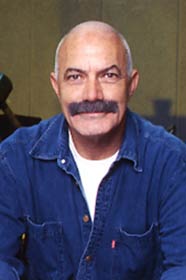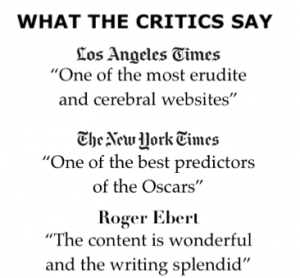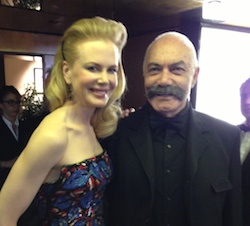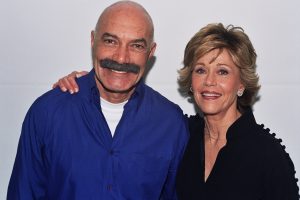Toronto Film Fest 1993–Whether or not you think Leni Riefesntahl, the German filmmaker who produced seminal Nazi propaganda movies, is the greatest woman director of all time, you should see Ray Muller’s three-hour documentary, The Wonderful, Horrible Life of Leni Riefenstahl.
| The Wonderful, Horrible Life of Leni Riefenstahl |
|
|---|---|

|
|
The film, which premiered at the 1993 Toronto Film Festival, is now playing at the Nuart Theatre for a two-week run.
Any discussion restricted to Riefenstahl as a filmmaker doesn’t do justice to the complex, multi-faceted and ultimately evasive personality of a woman, who began as an actress in silent German films (The Holy Mountain, 1926), functioned as Hitler’s favorite filmmaker, and went on to become an international celebrity as a photographer.
At 91, Riefenstahl looks and sounds much younger than her age. Lucid and physically active, these days she is an avid scuba diver. Like her compatriot and contemporary, Marlene Dietrich, she belongs to a generation of strong women, who continued to reinvent themselves, making a lifetime work out of protecting their legendary status. Despite differences, the comparison with Dietrich is relevant, as Dietrich too fought with Maximillian Schell (allowing him to record her voice but not to show her face), while he was making Marlene, one of the most entertaining and illuminating documentaries I have seen.
The controversy over Riefenstahl is less about the merits of her films than the supposedly Faustian deal she struck with Hitler. She has been accused not so much of distorting reality as actually creating it, in Triumph of the Will (l934) and in her undisputed masterpiece, Olympia (l936).
I still get chills when I watch Triumph of the Will, based on the realization that the German masses cheering Hitler were not film extras, but real living individuals. Stylistically, both Triumph of the Will and Olympia, with their innovative camera angles and arithmetic compositions, are brilliant, attesting to Riefenstahl’s remarkable vision and obsessive attention to detail.
Riefenstahl tells Muller that Hitler wasn’t particularly interested in the Olympics. But he recognized the potential of the event for promoting his vision for a New Germany. In this respect, Albert Speer’s Olympic Stadium was the first monument to the Nazi regime. Over a year in the editing, Olympia had its world premiere on the Fuehrer 49th birthday in a gala attended by the elite of the Nazi party and film industry. Sponsored by the government, Riefenstahl took the film on a world tour, which included the U.S.
Muller’s failure to provide a broader political context is indicative of the documentary’s strategy–the movie is strong on personality, but weak on analysis and interpretation; perhaps he wanted viewers to make up their own minds. Muller shows doubts over Riefenstahl’s claim that she stayed in Germany as a “bulwark against anti-Semitism,” but he doesn’t challenge her outrageous assertion that she abhorred Hitler’s racial theories.
It’s a strange documentary, for there are virtually no witnesses except for Riefenstahl. There’s also not much about Riefenstahl’s notorious romantic relationships. We still don’t know how close she was to Hitler, though despite her best efforts, her eyes light up when she talks about the fuehrer!
Muller notes in his documentary that “the looming close-ups of Hitler were the first that the German people had seen.” We get the impression that Riefenstahl helped make a star out of Hitler due to the extraordinary power of her imagery. At the same time, it’s important to remember that as a political leader, Hitler was a charismatic orator who knew how to use radio effectively.
At one point in Muller’s friendly interview with Riefenstahl, he asks her if she fulfilled her “moral responsibility” as an artist. Instead of providing a direct answer, she poses him a question: Does he think Russian filmmakers Eisenstein and Pudovkin should have spoken out against Stalin’s atrocities.
Tried at Nuremberg after the war, Riefenstahl was declared a Nazi “supporter.” Though she never joined the Nazi Party, and never was politically active apart from her films for the Party, she has made enough incriminating statements to qualify as Nazi “sympathizer.” Nonetheless, Riefenstahl still insists that she is an apolitical artist and guilty of nothing.
Riefenstahl completed her last film in 1952 and went to Africa in the 1960s to produce two books of photographs of the Nuban tribes.
At the age of 72, she took up scuba diving, resulting in a book of underwater photos. Today, she is at work on an underwater film.
Muller also doesn’t deal with the German reaction to a beautiful and sexy woman who showed the “boys” how to make documentaries, a film genre that has always been dominated by men. But with all my criticism, I would like to stress that Muller’s comprehensive documentary not only provides an unflinching examination of Riefenstahl’s aesthetics and politics, but also includes clips from every one of her projects, many of them never seen before.
The Wonderful, Horrible Life of Leni Riefenstahl is a must-see for serious film and history students.
Directed, written by Ray Müller
Produced by Jacques de Clercql Dimitri de Clercq Waldemar Januzczak, Hans Peter Kochenrath, Hans-Jürgen Panitz
Cinematography: Michel Baudour, Walter A. Franke, Ulrich Jänchen, Jürgen Martin
Edited by Vera Dubsikova, Beate Köster
Music by Ulrich Bassenge, Wolfgang Neumann
Distributed by Kino
Release date: September 11, 1993 (TIFF)
Running time: 188 minutes
Box office $449,707 (USA)










